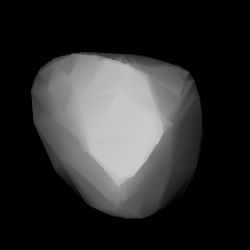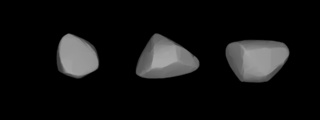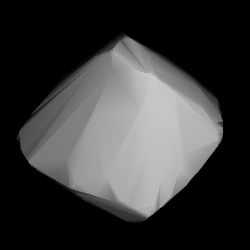Related Research Articles
Pawlowia, provisional designation 1923 OX, is a background asteroid from the central regions of the asteroid belt, approximately 20 kilometers in diameter. It was discovered on 5 October 1923, by Soviet astronomer Vladimir Albitsky at the Simeiz Observatory on the Crimean peninsula. The asteroid was named after Russian physiologist and Nobelist Ivan Pavlov.

1073 Gellivara, provisional designation 1923 OW, is a dark Themistian asteroid, approximately 27 kilometers in diameter, located in the outer regions of the asteroid belt. It was discovered by Austrian astronomer Johann Palisa at the Vienna Observatory on 14 September 1923, and later named after the Swedish town of Gällivare.
1047 Geisha, provisional designation 1924 TE, is a stony Florian asteroid from the inner regions of the asteroid belt, approximately 11 kilometers in diameter. It was discovered on 17 November 1924, by German astronomer Karl Reinmuth at the Heidelberg-Königstuhl State Observatory in southwest Germany. The asteroid was named after the British musical The Geisha.
1462 Zamenhof, provisional designation 1938 CA, is a carbonaceous Themistian asteroid from the outer regions of the asteroid belt, approximately 27 kilometers in diameter. It was discovered on 6 February 1938, by Finnish astronomer Yrjö Väisälä at the Iso-Heikkilä Observatory in Finland. The asteroid was named after L. L. Zamenhof, the creator of Esperanto. It is a recognized Zamenhof-Esperanto object.
1120 Cannonia, provisional designation 1928 RV, is a stony Florian asteroid from the inner regions of the asteroid belt, approximately 10 kilometers in diameter. Discovered by Pelageya Shajn at Simeiz in 1928, it was named after American astronomer Annie Jump Cannon.

1165 Imprinetta, provisional designation 1930 HM, is a carbonaceous Meliboean asteroid from the outer regions of the asteroid belt, approximately 49 kilometers (30 mi) in diameter. It was discovered on 24 April 1930 by Dutch astronomer Hendrik van Gent at the Union Observatory in Johannesburg, South Africa. The asteroid was named after Imprinetta Gent, wife of the discoverer.
11277 Ballard, provisional designation 1988 TW2, is a Phocaea asteroid from the inner regions of the asteroid belt, approximately 6.3 kilometers (3.9 miles) in diameter. It was discovered on 8 October 1988, by American astronomer couple Carolyn and Eugene Shoemaker at the Palomar Observatory in California. The assumed S-type asteroid has a rotation period of at least 10 hours. It was named for American marine scientist Robert Ballard.
1707 Chantal, provisional designation 1932 RL, is a stony background asteroid from the Florian region in the inner asteroid belt, approximately 7.5 kilometers in diameter. It was discovered on 8 September 1932, by astronomer Eugène Delporte at the Royal Observatory of Belgium in Uccle. The S-type asteroid has a rotation period of at least 10 hours. It was named for Chantal, the niece of Belgian astronomer Georges Roland.
9298 Geake, provisional designation 1985 JM, is a Mitidika asteroid from the central regions of the asteroid belt, approximately 12 kilometers in diameter. It was discovered on 15 May 1985, by American astronomer Edward Bowell at Lowell Observatory's Anderson Mesa Station near Flagstaff, Arizona, United States. The asteroid was named for British astronomer John E. Geake.
4000 Hipparchus is a dark background asteroid from the central regions of the asteroid belt, approximately 17 kilometers in diameter. It was discovered on 4 January 1989, by Japanese astronomers Seiji Ueda and Hiroshi Kaneda at the Kushiro Observatory on Hokkaido, Japan. The likely carbonaceous asteroid has a short rotation period of 3.4 hours. It was named for the ancient Greek astronomer Hipparchus.
1452 Hunnia, provisional designation 1938 DZ1, is a carbonaceous Meliboean asteroid from the outer regions of the asteroid belt, approximately 20 kilometers in diameter. It was discovered on 26 February 1938, by Hungarian astronomer György Kulin at the Konkoly Observatory in Budapest. The asteroid was named in honor of the Hungarian nation.
1532 Inari, provisional designation 1938 SM, is a stony Eoan asteroid from the outer regions of the asteroid belt, approximately 28 kilometers in diameter. Discovered by Yrjö Väisälä at Turku Observatory in 1938, it was later named for Lake Inari in northern Finland.
2324 Janice, provisional designation 1978 VS4, is a dark background asteroid from the outer regions of the asteroid belt, approximately 25 kilometers (16 miles) in diameter. It was discovered on 7 November 1978, by American astronomers Eleanor Helin and Schelte Bus at the Palomar Observatory in California. The asteroid was named for Janice Cline at Caltech. The presumably C-type asteroid has a rotation period of 23.2 hours.
3714 Kenrussell, provisional designation 1983 TT1, is a Eunomian asteroid from the central regions of the asteroid belt, approximately 10 kilometers (6 miles) in diameter. It was discovered on 12 October 1983, by American astronomer Edward Bowell at the Anderson Mesa Station near Flagstaff, Arizona, in the United States. It was named for Australian astronomer Kenneth S. Russell. The presumably stony asteroid has a rotation period of 5.25 hours.
4944 Kozlovskij, provisional designation 1987 RP3, is a carbonaceous Witt asteroid from the central regions of the asteroid belt, approximately 10 kilometers (6 miles) in diameter. It was discovered on 2 September 1987, by Soviet astronomer Lyudmila Chernykh at the Crimean Astrophysical Observatory in Nauchnij, on the Crimean Peninsula. The asteroid was named for Russian opera singer Ivan Kozlovsky.
1303 Luthera, provisional designation 1928 FP, is a dark asteroid and the parent body of the Luthera family, located in the outermost regions of the asteroid belt. It measures approximately 90 kilometers in diameter. The asteroid was discovered on 16 March 1928, by astronomer Friedrich Schwassmann at the Bergedorf Observatory in Hamburg, Germany, and later named after German astronomer Robert Luther.
1990 Pilcher, provisional designation 1956 EE, is a stony background asteroid from the Florian region of the inner asteroid belt, approximately 7 kilometers in diameter. It was discovered on 9 March 1956, by German astronomer Karl Reinmuth at the Heidelberg-Königstuhl State Observatory in Heidelberg, Germany. In 1982, it was named by the MPC for American physicist and photometrist Frederick Pilcher. The S-type asteroid has a short rotation period of 2.8 hours.

1518 Rovaniemi, provisional designation 1938 UA, is a stony Florian asteroid from the inner regions of the asteroid belt, approximately 8 kilometers in diameter. Discovered by Yrjö Väisälä at the Turku Observatory in 1938, the asteroid was later named after the Finnish city of Rovaniemi.

1430 Somalia, provisional designation 1937 NK, is a stony background asteroid from the central regions of the asteroid belt, approximately 10 kilometers in diameter. It was discovered on 5 July 1937, by astronomer Cyril Jackson at the Union Observatory in Johannesburg. It was named for the African country of Somalia.
2169 Taiwan, provisional designation 1964 VP1, is a carbonaceous Astridian asteroid from the central regions of the asteroid belt, approximately 17 kilometers in diameter. It was discovered on 9 November 1964, by astronomers at the Purple Mountain Observatory near Nanking, China. It was named for Taiwan.
References
- 1 2 3 4 5 "1671 Chaika (1934 TD)". Minor Planet Center. Retrieved 10 December 2018.
- 1 2 3 Schmadel, Lutz D. (2007). "(1671) Chaika". Dictionary of Minor Planet Names. Springer Berlin Heidelberg. p. 133. doi:10.1007/978-3-540-29925-7_1672. ISBN 978-3-540-00238-3.
- 1 2 3 4 "JPL Small-Body Database Browser: 1671 Chaika (1934 TD)" (2018-10-18 last obs.). Jet Propulsion Laboratory . Retrieved 10 December 2018.
- 1 2 "Asteroid 1671 Chaika". Small Bodies Data Ferret. Retrieved 10 December 2018.
- 1 2 "Asteroid (1671) Chaika – Proper elements". AstDyS-2, Asteroids – Dynamic Site. Retrieved 10 December 2018.
- 1 2 3 4 Mainzer, A. K.; Bauer, J. M.; Cutri, R. M.; Grav, T.; Kramer, E. A.; Masiero, J. R.; et al. (June 2016). "NEOWISE Diameters and Albedos V1.0". NASA Planetary Data System: EAR-A-COMPIL-5-NEOWISEDIAM-V1.0. Bibcode:2016PDSS..247.....M . Retrieved 10 December 2018.
- 1 2 3 4 Masiero, Joseph R.; Mainzer, A. K.; Grav, T.; Bauer, J. M.; Cutri, R. M.; Nugent, C.; et al. (November 2012). "Preliminary Analysis of WISE/NEOWISE 3-Band Cryogenic and Post-cryogenic Observations of Main Belt Asteroids". The Astrophysical Journal Letters. 759 (1): 5. arXiv: 1209.5794 . Bibcode:2012ApJ...759L...8M. doi:10.1088/2041-8205/759/1/L8.
- 1 2 3 4 Mainzer, A.; Grav, T.; Masiero, J.; Hand, E.; Bauer, J.; Tholen, D.; et al. (November 2011). "NEOWISE Studies of Spectrophotometrically Classified Asteroids: Preliminary Results". The Astrophysical Journal. 741 (2): 25. arXiv: 1109.6407 . Bibcode:2011ApJ...741...90M. doi:10.1088/0004-637X/741/2/90. (catalog)
- 1 2 3 4 Hasegawa, Sunao; Müller, Thomas G.; Kuroda, Daisuke; Takita, Satoshi; Usui, Fumihiko (April 2013). "The Asteroid Catalog Using AKARI IRC Slow-Scan Observations". Publications of the Astronomical Society of Japan. 65 (2): 11. arXiv: 1210.7557 . Bibcode:2013PASJ...65...34H. doi:10.1093/pasj/65.2.34.
- 1 2 Behrend, Raoul. "Asteroids and comets rotation curves – (1671) Chaika". Geneva Observatory. Retrieved 10 December 2018.
- 1 2 3 4 5 "LCDB Data for (1671) Chaika". Asteroid Lightcurve Database (LCDB). Retrieved 10 December 2018.
- ↑ Nesvorný, D.; Broz, M.; Carruba, V. (December 2014). "Identification and Dynamical Properties of Asteroid Families". Asteroids IV. pp. 297–321. arXiv: 1502.01628 . Bibcode:2015aste.book..297N. doi:10.2458/azu_uapress_9780816532131-ch016. ISBN 9780816532131.
- ↑ Schmadel, Lutz D. (2009). "Appendix – Publication Dates of the MPCs". Dictionary of Minor Planet Names – Addendum to Fifth Edition (2006–2008). Springer Berlin Heidelberg. p. 221. doi:10.1007/978-3-642-01965-4. ISBN 978-3-642-01964-7.
- ↑ Menke, John; Cooney, Walt; Gross, John; Terrell, Dirk; Higgins, David (October 2008). "Asteroid Lightcurve Analysis at Menke Observatory". The Minor Planet Bulletin. 35 (4): 155–160. Bibcode:2008MPBu...35..155M. ISSN 1052-8091.